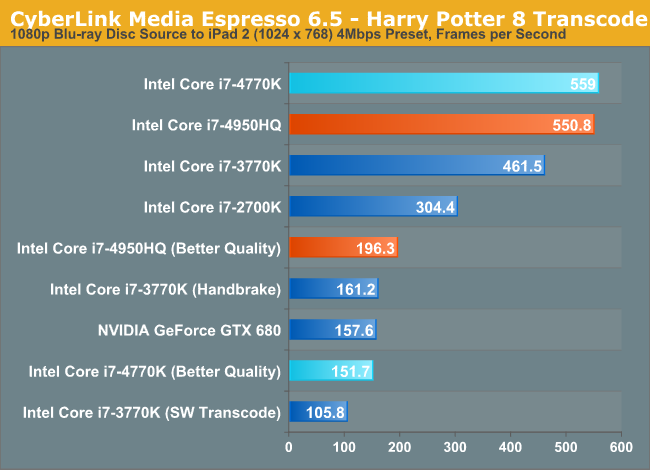The Haswell Review: Intel Core i7-4770K & i5-4670K Tested
by Anand Lal Shimpi on June 1, 2013 10:00 AM ESTQuick Sync Performance
With more graphics EUs under the hood of all desktop Haswells (at least those launching today), Quick Sync performance improves a bit over Ivy Bridge. Intel claims to have focused heavily on improving the quality of Quick Sync transcodes however in my testing I saw a slight regression in quality. I didn’t have a ton of time to dig further to find out what’s going on but I plan on doing so post-Computex. Update: It looks like I wasn't alone in seeing an image quality regression. Haswell QSV image quality is worse than on IVB as Ganesh found.
The other big news is Handbrake now officially supports Quick Sync, something Ganesh will be testing with his HTPC look at Haswell.
Needless to say, Quick Sync performance is better on Haswell than on Ivy Bridge. And it’s even better if you happen to have a Haswell with a 128MB L4 cache.











210 Comments
View All Comments
Ninokuni - Saturday, June 1, 2013 - link
"The new active idle (S0ix) states are not supported by any of the desktop SKUs"Does this mean the whole PSU haswell compatability issue is now irrelevant?
jhoff80 - Saturday, June 1, 2013 - link
I believe that PSU issue was in relation to the C6 and C7 states, not S0ix.smilingcrow - Saturday, June 1, 2013 - link
Correct as desktop PSUs are used with desktop CPUs. :)Egg - Saturday, June 1, 2013 - link
To reiterate owikh84, there appears to be a serious typo in the title - it should be 4670k, not what appears to be a nonexistent 4560k part.RaistlinZ - Saturday, June 1, 2013 - link
This review was a bit more positive than the one at Guru3d. Their numbers show the performance difference being almost nothing. Guess my i7-930 @4Ghz will dredge on for another generation.chizow - Saturday, June 1, 2013 - link
I'd consider it but the IPC gains alone since Nehalem make the upgrade worthwhile, and the rest of the X58 specs are already sagging badly. It still does OK with PCIE bandwidth due to the 40 total PCIE 2.0 lanes, but 20 PCIE 3.0 lanes is equivalent with PCIE 3.0 cards. The main benefit however is running SATA 6G for my SSDs and gaining some USB 3.0 ports for enclosures, etc. They have been bottlenecked for too long on SATA 3G and USB 2.0.I would consider waiting for IVB-E or Haswell-E but Intel always drags their feet and ultimately, these solutions still end up feeling like a half step back from the leading edge mainstream performance parts.
zanon - Saturday, June 1, 2013 - link
Intel's artificial segmentation of some features are more irritating then others, but not including VT-d everywhere really, really sucks. An IOMMU isn't just helpful for virtualization (and virtualization isn't just a "business" feature either), it's critical from a security standpoint if an OS is to prevent DMA attacks via connected devices (and just helping increase stability also). It should be standard, not a segmentation feature.klmccaughey - Monday, June 3, 2013 - link
Yea, I just don't get why they dropped VT-d. Really silly. A lot of power users on the desktop use virtualisation.Chriz - Saturday, June 1, 2013 - link
I'm curious about something. If you say Intel got rid of legacy PCI support in the 8 series chipsets, why am I still seeing PCI slots on these new motherboards being released? Are they using third party controllers for PCI?CajunArson - Saturday, June 1, 2013 - link
"Are they using third party controllers for PCI?"Yes.